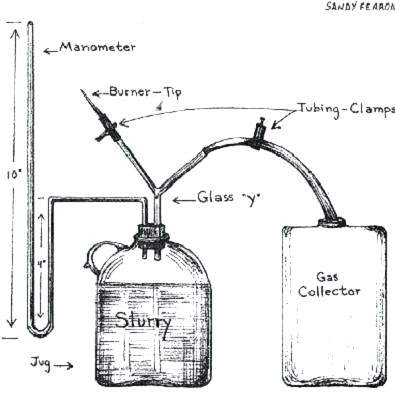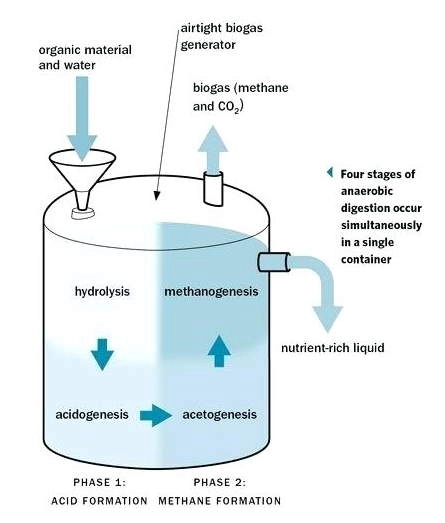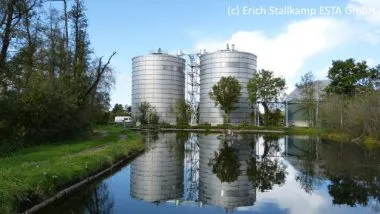How to build and run a small lab scale Pilot-plant Biogas Reactor to carry out the anaerobic digestion of plant biomass (waste organic materials you have available to you for free or at minimal cost) with an A.D. pilot plant experiment, sometimes called a Lab Trial.
This is an experimental pilot plant laboratory method to prove whether a good gas yield can be expected from any organic waste which we break down into steps and each step is explained.

We simply apply the scientific method to our problem, that being to work out how to start and run a pilot trial on the anaerobic digestion of plant biomass and gather data on the performance of the process.
This is the experimental method for anyone to find out how much biogas they can hope to get from their biomass source. It is the only way to find out the biogas plant configuration best for any particular organic feed material.
In anaerobic digestion, theory and calculation can only take you so far. Sooner or later, there must be experimentation to prove or disprove the theory.
This method can be applied to all biogas plant designs, even advanced processes.
How to Run a Biogas Pilot Scale (Laboratory) Trial Step by Step
These steps can also be used to start a home-biogas plant, but we recommend that if you bought a proprietary brand domestic AD plant, and did not make up your own DIY design, you should follow the instructions provided by the seller/ manufacturer.
Step 1.
Cut and mash the plant biomass by hand until the pieces are crushed and small, and mix with enough water to make a sloppy slurry. You should seek to achieve a suitable total solids content of 5 to 10% by volume. To get an idea of what that looks like, try measuring the biomass and water before you start.
Step 2.
Once mixed, adjust the pH of this mixture to approximately 7 pH units using sodium bicarbonate.
Step 3.
 Mix with a determined amount of inoculum. The inoculum can be either digested sludge, pats of dung, or concentrated cow manure. All of these will contain organisms capable of producing methane. Check the pH of the new mixture and ensure it is within the optimum range for the anaerobic digestion process (6.8-7.5pH).
Mix with a determined amount of inoculum. The inoculum can be either digested sludge, pats of dung, or concentrated cow manure. All of these will contain organisms capable of producing methane. Check the pH of the new mixture and ensure it is within the optimum range for the anaerobic digestion process (6.8-7.5pH).
Step 4.
Place the biomass mixture in an air-tight reactor. The reactor can be simple conical flasks or glass bottles with a rubber septum or bigger reactors such as stainless steel purpose-built digesters. For example 150 Litre drums, or 1 m3 Intermediate Bulk Containers (IBCs).
Step 5.
Place the reactor in an environment maintained at 35°C (mesophilic) or 60°C (thermophilic). If you intend to use the larger reactor size, make sure that you have a way to keep those heated. You may leave the reactor in ambient conditions but the methane yields will then be much lower, and are likely to take longer to get started.
Step 6.
Leave the digestion process and measure biogas volume daily by recording in a notebook or table the downward displacement of acidified water in a standpipe.
Step 7.
If you want to remove CO2 from the biogas, bubble the gas through an alkaline solution of NaOH or Ca(OH)2. The gas obtained will then be mainly methane gas.
Step 8.
If you want to remove H2S from the biogas, bubble through steel wool.
Step 9. Trial and Error – Rinse and Repeat!
If at first you don't succeed – try, try, and try again!
You have to design the digester according to the feedstock. So, if no biogas is produced after say 30 days it is clear that it will be necessary to vary some of the digester conditions.
But, before you do that do make sure that some other physical problem did not occur which prevented the necessary anaerobic conditions from being created.
ONLY CHANGE ONE THING AT A TIME!

At this point it is a case of informed guessing, making a change to one parameter and re-starting your trial again.
Carry on learning by trial and error until you become an expert! The experience is an extremely valuable one.
Allow yourself plenty of time, and don't get dispirited if experiments don't work. Failure is a big part of learning. Count your luck that you learnt on a small-scale pilot trial, and remember that the cost is minimal compared to gaining the same experience on a full-scale biogas plant.
Tips to Help You Get Started with Woody Materials and Wastewater Sludge
if your initial trial is slow to start to produce biogas you probably have one of the feed materials which is harder for the micro-organisms to digest.
In order to treat plant material or agriculture residue through A.D., it may need to pretreatment i.e chemical, biological or mechanical. This breaks down the outer-ell walls and makes it easier for microbes to digest.

C:N Ratio
If an initial trial is not very successful you may need to adjust the C:N ratio of your plant biomass (feedstock material). It should be at least near 30:1.
To achieve it you may add cattle dung or urine or urea at your convenience. You can use the C:N ratios quoted for composting.
Other Factors to Consider for Successful Anaerobic Digestion
Operational conditions of the anaerobic process such as pH, temperature, organic loading, alkalinity, startup, solids, Vss, HRT, SRT, and many others are factors needed to be considered to obtain good results from the anaerobic process.
The factors which apply to plants such as fresh grass, potatoes, leaves etc., will not be the same as for manure, or treatment sludges.
It depends very much on your feedstock type. That's why people do their own trials in small reactor flasks or similar until they are confident that they have found the best way to run their pilot-scale “experiments”.
Don't forget either that you will always need some inoculum. Inoculum can be anaerobically fermented sludge or cow dung, in fact, any dung from herbivore animals contains anaerobic microorganisms able to start the process.
Particle size matters a lot for biological processes, thus try to use disintegration techniques such as crushing to reduce particle size. If you have different substrates such as food waste, you can introduce anaerobic co-digestion by mixing with plant biomass.
This has to be done carefully by manipulating parameters such as C:N ratio of the mixed feed. via www.researchgate.net
Starting Up Specialised and More Advanced Anaerobic Digestion Processes
Anaerobic digesters are designed and engineered to operate using a number of different configurations.
These can be categorized into batch vs. continuous process mode, mesophilic vs. thermophilic temperature conditions, high vs. low portion of solids, and single stage vs. multistage processes. Above this level is considered high solids content, and can also be known as dry digestion.
In addition, anaerobic digestion can be performed as a batch process or a continuous process. In a batch system, biomass is added to the reactor at the start of the process. The reactor is then sealed for the duration of the process.
Pilot trials for all of the many processes start by getting the single-stage process working optimally first with any given feed-stock biomass material.
Once the process engineer or laboratory technician has a successful single-stage CSTR-type system established, they go on to use a reduced-size version of the type of process which will be used in the final design. That way a more advanced design can be optimised for any feedstock biomass, and the approximate biogas yield found. That data is used to calculate whether the biogas yield will be sufficient to give an adequate return on investment (ROI) when the scale is factored up to a full-scale biogas plant.
In the same way, pilot scale trials can be set up to assess the effectiveness of additional substrate pre-treatment stage technologies.
These can be used to reduce the necessary retention time to produce biogas.
For example, certain processes shred the substrates to increase the surface area or use a thermal pre-treatment stage (such as pasteurisation) to significantly enhance the biogas output. The pasteurisation process will have the additional benefit of reducing the pathogenic concentration in the digestate leaving the anaerobic digester. The effectiveness of pasteurisation which will be achieved by heat treatment, combined with maceration of the solids can also be trialled before the digester design is finalised.
How Long Does it Take to Complete a Biogas Plant Trial?
There are a number of variables that can affect how long it takes to complete a pilot-scale biogas test, including the type of feedstock utilised, the design of the biogas system, and the goals of the experiment. In order to get accurate and representative data, the testing period can last anywhere from a few weeks to several months.
Biogas production and composition should be monitored often during early testing to ensure a well-functioning system. The optimal feedstock composition and other operating parameters may need to be fine-tuned as testing develops.
To properly evaluate the pilot plant's long-term viability, the testing period needs to be long enough to ensure stable performance. In order to get reliable results, most experts advise running the system for at least three months. In the event of problems or the need for more information to conduct an in-depth study, the testing time may be extended.
Safety Warning:
Always take due precautions when explosive gas is present. Refer to explosion safety regulations which apply in your location, and apply them.
Health Warning:
Take due care to ensure that you take all due precautions against infection caused by handling waste organic materials. Refer to all health, safety and welfare regulations which apply in your location, and apply them.
Disclaimer:
If you use the suggested method given here you are only allowed to do so if you accept that we take no responsibility for the correctness or completeness or any other aspect of the content on this page. We accept no liability. See also our general disclaimer page.




